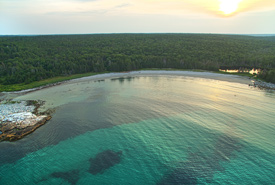The Port Joli and Port L’Hebert Coastal Area

Aerial view of Port Joli, NS, showing its white sandy beach and aquamarine waters (Photo by Mike Dembeck)
Land conservation is like working on a jigsaw puzzle — it is most strategic to add pieces to existing sections, and it happens faster when done together.
The Port Joli and Port L’Hebert peninsulas and surrounding area are home to one of the largest concentrations of coastal protected areas in the province, including the Kejimkujik National Park Seaside Adjunct National Park (2,417 hectares), Thomas Raddall Provincial Park (615 hectares) and the adjacent Port L'Hebert Nature Reserve (691 hectares).
Since 2006, the Nature Conservancy of Canada (NCC) has been assembling properties and adding new pieces to this ecological puzzle. During this time, NCC has been successful in conserving over 1,600 hectares on Nova Scotia's south shore. You can still play a part in contributing to our ongoing conservation efforts in this area.
The Port Joli and Port L’Hebert peninsulas and surrounding coastal areas feature a stretch of coastline that gives rise to large, shallow-water basins with significant coastal habitat diversity, including sandy beaches and extensive intertidal salt marshes, freshwater wetlands and Wabanaki (Acadian) forest, which offer tremendous value to wildlife.
The upper half of the Port Joli basin is a designated Migratory Bird Sanctuary, managed by Environment Canada and governed by the Migratory Birds Convention Act. This sanctuary covers roughly 335 hectares of the basin and is composed of intertidal flats vegetated by eelgrass. Four other Migratory Bird Sanctuaries exist within the area, totalling 5,260 hectares of protected habitat.
The Port Joli and Port L’Hebert peninsulas are recognized for their significant density of uncommon and rare cyanolichen species, including the globally rare, nationally, and provincially listed endangered boreal felt lichen and vole ears lichen, the provincially vulnerable blue felt lichen and the provincially threatened black-foam lichen, which is also a committee on the Status of Endangered Wildlife in Canada species of special concern. With multiple occurrences of these species in the area, this site is among one of the most significant sites for these rare and endangered lichens in Nova Scotia.
Double your impact; your gift will be matched dollar for dollar!





